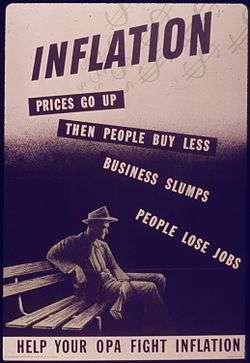Office of Price Administration
 An OPA propaganda poster used to remind citizens about inflation. | |
| Agency overview | |
|---|---|
| Formed | August 28, 1941 |
| Preceding | |
| Dissolved | May 29, 1947 |
| Superseding agencies |
|
| Jurisdiction | United States Government |
| Headquarters | Washington, D.C. |
| Agency executives |
|
| Parent agency | Office for Emergency Management |
The Office of Price Administration (OPA) was established within the Office for Emergency Management of the United States government by Executive Order 8875 on August 28, 1941. The functions of the OPA were originally to control money (price controls) and rents after the outbreak of World War II.[3]
History
President Franklin D. Roosevelt revived the Advisory Commission to World War I Council on National Defense on May 29, 1940, to include Price Stabilization and Consumer Protection Divisions. Both divisions merged to become the Office of Price Administration and Civilian Supply (OPACS) within the Office for Emergency Management by Executive Order 8734, April 11, 1941. Civil supply functions were transferred to the Office of Production Management.[1]
It became an independent agency under the Emergency Price Control Act, January 30, 1942. The OPA had the power to place ceilings on all prices except agricultural commodities, and to ration scarce supplies of other items, including tires, automobiles, shoes, nylon, sugar, gasoline, fuel oil, coffee, meats and processed foods. At the peak, almost 90% of retail food prices were frozen. It could also authorize subsidies for production of some of those commodities.[4]
Most functions of the OPA were transferred to the newly established Office of Temporary Controls (OTC) by Executive Order 9809, December 12, 1946. The Financial Reporting Division was transferred to the Federal Trade Commission.
The OPA was abolished effective May 29, 1947, by the General Liquidation Order issued March 14, 1947, by the OPA Administrator. Some of its functions were taken up by successor agencies:
- Sugar and sugar products distribution by the Sugar Rationing Administration in the Department of Agriculture pursuant to the Sugar Control Extension Act (61 Stat. 36), March 31, 1947
- Price controls over rice by the Department of Agriculture by Executive Order 9841, on April 23, 1947, effective May 4, 1947
- Food subsidies by the Reconstruction Finance Corporation, effective May 4, 1947
- Rent control by the Office of the Housing Expediter, effective May 4, 1947
- Price violation litigation by the Department of Justice, effective June 1, 1947
- All other OPA functions by the Division of Liquidation, Department of Commerce, effective June 1, 1947.
Famous employees include economist John Kenneth Galbraith, legal scholar William Prosser, and President Richard Nixon.
The OPA is featured, in fictionalized form as the Bureau of Price Regulation, in Rex Stout's Nero Wolfe mystery novel The Silent Speaker.
During the Korean War, similar functions were performed by the Office of Price Stabilization (OPS).
Administrators of the office
- Leon Henderson, 1941–1942
- Prentiss Marsh Brown, 1943
- Chester Bliss Bowles, 1943–1946
OPA points
OPA points are small vulcanized fibre red and blue ration tokens issued during World War II to make change for ration coupons. Approximately 1.1 billion red and 0.9 billion blue were produced, and even though many were collected and destroyed after the war, they are still quite common today. The red OPA points are a bit more common than the blue. Each token has two letters on it, and some people collect them by letter combination.[5]
Gallery
- An OPA menu with ceiling prices.
.jpg) A mileage ration book issued by the OPA.
A mileage ration book issued by the OPA. Red and blue OPA points.
Red and blue OPA points.
See also
| Wikimedia Commons has media related to Office of Price Administration. |
- Office of Economic Stabilization
- Stabilization Act of 1942
- United States home front during World War II
References
- 1 2 Herman, Arthur. Freedom's Forge: How American Business Produced Victory in World War II, pp. 127, 137-9, Random House, New York, NY, 2012. ISBN 978-1-4000-6964-4.
- 1 2
- ↑ Video: Baby Bonds For Defense, 1941/04/17 (1941). Universal Newsreel. 1941. Retrieved February 20, 2012.
- ↑ Herman, Arthur. Freedom's Forge: How American Business Produced Victory in World War II, pp. 153, 162-5, 171, Random House, New York, NY, 2012. ISBN 978-1-4000-6964-4.
- ↑ "Forrest's Token Page: Sales Tax Tokens". Retrieved 2014-02-28.
Further reading
- Auerbach, Alfred. The OPA and Its Pricing Polices. New York: Fairchild, 1945.
- Bartels, Andrew H. The Office of Price Administration and the Legacy of the New Deal, 1939-1946. Public Historian, (1983) 5:3 pp. 5–29. JSTOR
- Bartels, Andrew H. The Politics of Price Control: The Office of Price Administration and the Dilemmas of Economic Stabilization, 1940-1946. (Ph.D. dissertation, The Johns Hopkins University, 1980.)
- Galbraith, J. K. The Selection and Timing of Inflation Controls. Review of Economics and Statistics, (1941) 23:2 pp. 82–85. JSTOR
- Galbraith, John Kenneth. A Theory of Price Control. Boston, Harvard University Press, 1952.
- Galbraith, John Kenneth. A Life in Our Times: Memoirs. 1981.
- Hirsch, Julius. Price Control in the War Economy. New York: Harper and Brothers, 1943.
- Mansfield, Harvey. A Short History of OPA. Washington, 1947.
- Office of Temporary Controls. The Beginnings of OPA. Washington, D.C.: U.S. Government Printing Office, 1947.
- Thompson, Victor A. The Regulatory Process in OPA Rationing. New York: King's Crown Press, 1950.
- Wilson, William Jerome, and Mabel Randolph. OPA Bibliography, 1940–1947. Washington, D.C.: U.S. Government Printing Office, 1948.